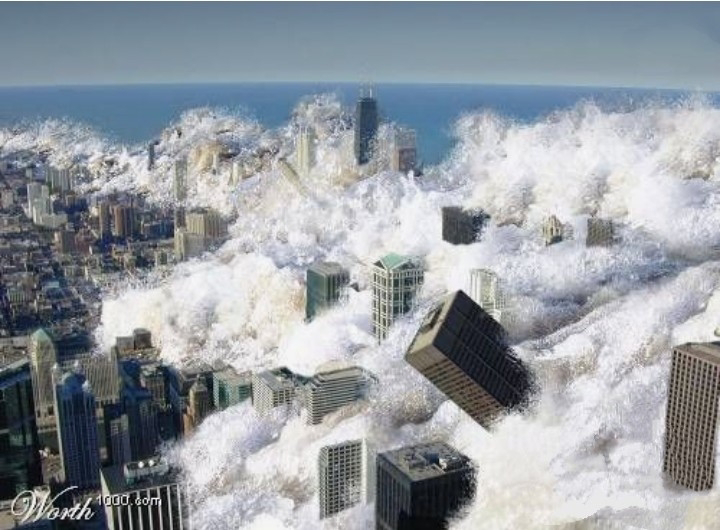physical map of North America
Physical map of North America
* Third largest continent
* 16.5% of world's land area
* 7.7% of worlds population
* Was discovered by Christopher Columbus in 1492 AD.
* It is an after Amerigo Vaspucci.
* New world continent was new to 15th century European explorers
* Triangle Shaped Continent located in Northern and Western Hemisphere.
* Latitude - approx 7° to 84° N
* Longitude - approx 15° to 180°
* Associated Islands - Greenland ( largest island in world) Arctic Archipelago, west insides, Ateutian islands.
* Arctic Cirle (66.5° N) runs through Northern part and Tropic of Cancer (23.5° N ) runs through southern part of the continent.
* North America, stretching from polar Arctic to Tropical Caribbean, supports almost all major types of biomes.
* Surrounded by Arctic Ocean in north. Atlantic Ocean in east, Pacific Ocean in west and South America in south.
* Separated from Asia by Bering Strait.
* Connected with South America through Isthmus of Panama.
* Greenland separated from Europe by Denmark strait.
* Highest point - Denali ( mount McKinley) in Alaska -6,194 meters above sea level.
* Lowest point - Death valley in California, at -282 feet (86 m) below sea level.
* Yellow stone national park in the US has some of worlds most active geysers.
* Canada's Bay of Fundy has greatest tidal range in the world
* Missippi river at 3,700 km (2,320 miles) long, is one of the longest river system in the world.
* North America has 23 officially recognised independent states.comprising North America mainland, Central America and Caribbean.
* Largest Country Canada, followed by also rather big the US
* These two gaints togather occupy more than 79% of the whole continent area
* The smallest country is Saint Kitts and Nevis, it is only 2 small islands in the Caribbean
North American mainland has-
1) United States of America ( U.S)
2) Alaska ( U.S )
3) Canada
4) Mexico
* Hawaii is the only U.S state located in Oceania: outside North America mainland and composed entirely of islands.
Physical features of North America
North America can be divided into four physical regions:
* The Mountainous west
* The Great plains
* The Canadian shield
* The Eastern Region
Mountainous west -
* Western cordilleras - There are young fold mountain ranges in the west spreading from Alska to Mexico
*It covers about extensive area of mountain ranges, intermontane basins, and plateaus in western. North America
* Sometimes also called Pacific Cordillera.
* These arose due to tectonic activities which deformed the Earths lithosphere
* This sequence of parallel ranges begins with Alaska Range and Brooks Range in Alaska and runs through Canada, US , Mexico and all the way to the Isthmus of Panama
* Starting with Alska Range and Brooks Range, runs through Mockenize MTS, coast MTS, Rocky MTS, Sierra Nevada,Sierra Madre and through the mountains ranges of Central America becomes Andes mountains of South America.
* The highest peak of North America is Mount McKinley or Mount Denali (6,194m) in Alaska range
Great plains
* Great plains are a vast high plateau of semiarid Grassland, -higher in the west than in east
* Located in the middle of the continent ( parts of US and Canada) between western cordilleras and Eastern high lands
* Drained by rivers, has deep and rich soil.
* Also called the ' Breadbasket ' of North America - grain grown in this region feeds a large part of the world.
* Also have rich deposit of oil and natural gas.
* North America Great Central plains consists of:
* Stepped grasslands ( known as prairies) in the central and western Portions.
* Hot and dry desert of South Western US ( Arizona, California, Taxes etc.) and Mexico
* Desert lie in a large basin between the Rockey mountains to the east and the Sierra Nevada to the west.
* North America has 4 major deserts: Great Basin, Mojave ( Mohave) Sonoran and Chihuahuan
The Canadian Shield :
* The Canadian shield is a raised but relatively flat plateau
* It extends over eastern, central, and northwestern Canada
* It is characterized by a rocky landscape pocked by an astounding number of lakes.
* The Tundra, stretching along the northern border of Alaska and Canada to the Hudson Bay area is a biome common to the Canadian shield
* The Tundra is characterized by Permafrost- soil that is frozen for two or more years. This Permafrost keeps moisture near soils surface. Promoting vegetation growth even in the extreme Arctic condition of the Tudra.
* It is also called the Laurentian Plateau.
Eastern Region -
* This varied region includes the Appalachian mountains ( older mountain ranges near the east coast of US and Canada) and the Atlantic Coastal plain.
* Atlantic Coastal plain extends from river, marsh and wetland region east of the mountains toward the Sandy beachs of the Atlantic Coast
* Wetiland areas are a biome of the eastern region and consist of areas of land whose soil is saturated with permanent or seasonal moisture.
* The Florida Everglades is the largest wetland system in the US covering more than 11,137²km (4,300 s. miles) of Southern Florida
Great lakes of North America :
They from planets largest area of freshwater they are a series of 5 large interconnected freshwater lakes in the upper mid- east region of North America that connect to the Atlantic Ocean via the saint Lawrence river.
1) Lake Superior ( largest of the Great lakes of North America and world's largest freshwater lake by surface area)
2. Lake Michigan
3. Lake Huron
4. Lake Erie
5. Lake Ontario
Other Lakes
* Great Bear Lake
* Great Slave Lake
* Athabasca Lake
* Reindeer Lake
* Winnipeg Lake
* The crater Lake is a spectacular Mountain Lake located in the Cascbe mountains of the US
* Carter Lake is the deepest Lake in US and 7th deepest lake in the world.
Important Waterfalls
* Niagara falls - located on Niagara river which connects 2 of the 5 Great lakes
- Lake Erie and Lake Ontario
* Olo' upena falls
* Yosemite falls
* Yellow stone falls
Etc.
Important Rivers :
Mississippi River System:
* Source: Lake Itasca, Minnesota
* Mouth: Gulf of Mexico
*Largest river basin of North America
* Major Tributaries: Missouri, Ohio
Colarado River
* Source: Rocky mountain National park
* Mouth: Gulf of California
* Froms Grand Canyon in Arizona
* Hoover Dam
Mecxenize River-
- longest river in Canada
- flows into Arctic Ocean
* Saint Lawrence River -
- Drains the Great Lakes
- flows into Atlantic Ocean
Important Mountain Ranges and peaks:
Rocky Mountains
* One of the longest fold mountains in the world and extends from Canada to western US ( New Mexico State)
* Highest peak: Mount Elbert
Appalachia Mountains
* Old fold mountain, rich in minerals resources.
* Highest peak: My. Mitchell
Alaska Range:
* Highest peak: MT . McKinley
* MT . McKinley highest peak in North America
Some Important Gulfs:
Gulf of Mexico
* Largest gulf in the world
* It is a marginal sea of Atlantic Ocean
Gulf of Alaska
* It is situated in the Northwestern part of North America
Gulf of California
* It separates Bajaj California Peninsula from the Mexican Mainland.
Gulf of ST Lawrence
*It is a water outlet of the North America Great Lakes via saint Lawrence river.
Important Seas :
*Beaufort Sea - it is situated in North of Canada and Alasy
* Labrador Sea - It separates Canada from Greenland
* Bering Sea- It is situated on the extreme North of North America separating the continents of Asia and North America.
Caribbean Sea-
- Bounded by Mexico and Central America to the west and south west
- To the north by the Greater Antilles starting with Cuba.
- To the east by the Lesser Antiles, and to the south by the north coast of South America.



Comments
Post a Comment